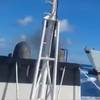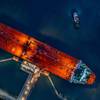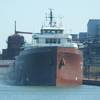There’s no denying that the wave owners rode into 2014 on was a welcome way to start the new year (at least from their perspective). Earnings in the large crude tanker segment reached levels that hadn’t been obtained in three years and in the smaller dirty segment, in five or more years. But, with all things in life, “what goes up must come down,” a famous quote by physicist and mathematician Sir Isaac Newton, that quickly became the mantra for the first quarter of 2014.
The prevailing factor behind the downturn in the crude tanker market was an overall decline in activity. Ultimately, this led to an increased oversupply situation, specifically in the VLCC segment. In January, there was a record high of 212 global spot VLCC fixtures recorded, 46% of which were destined to China and Singapore. That number was further reduced to 167 fixtures in February and 144 fixtures in March, a 32% decline over three months in spot activity without a corresponding increase in period chartering.(Fig 1)
Spot rates out of the Arabian Gulf, a major trading hub for VLCCs, fell in tandem with this decline. From an average of WS 55 in January, rates fell to an average of WS 43 in March on the AG/Japan benchmark trade. Meanwhile, rates from the AG to the US Gulf, lost an average of 6 WS points from January. VLCCs found some support from the growing West Africa/China trade due to the significant amount of ton-mile demand it provides them with. In 1Q 2014, there was an increase in fixture activity on this route by about 5% when compared to 1Q 2013. The downside to this is the number of owners looking to cash in on the earnings, effectively adding additional supply to the region. As a result, rates also fell throughout the first quarter from an average of WS 58 in January to WS 45 in March, a 22% decline. Fortunately for this overtonnaged sector, net fleet growth has been minimal. Our proprietary data showed that through March, there was a net fleet growth of two vessels.
Suezmaxes have also been subject to a decline in global fixture activity. Activity dropped from a healthy 226 fixtures in January to 200 in March. The bulk of the lack of volume has stemmed from the weakening WAFR/USAC trade. In the past, Suezmaxes dominated this trade, but since the increase in US domestic shale oil production, this route has essentially become non-existent. Since charterers rely mostly on VLCCs to transport their crude from West Africa to the Far East, longer-haul employment opportunities from this region have become increasingly limited for this class. Unless, of course, it becomes more cost effective to employ two Suezmaxes over one VLCC. We did see some of that transpire in the first quarter, which provided some support. But, for the most part, rates out of West Africa remained depressed like last year.
As shown in the figure 2, rates dipped from around the WS 111 level in January to an average of WS 62 in March, in line with last year’s low numbers. In the Black Sea/Mediterranean region, rates remained elevated at the beginning of the quarter on the back of the strong close at the end of 2013. However, as delays subsided and tonnage supply mounted, rates tumbled. On average, this route declined about 54% from January to March. One positive development for the Suezmax sector was that there was no net fleet growth in the first quarter.
In the Aframax sector, Caribbean rates in January traded at their highest levels in six years. Weather delays were the main culprit behind the surge in rates, which peaked at WS 305 in mid-January. As weather and activity subsided, rates fell throughout the rest of the quarter. By March, rates dipped to an average of WS 99, 10 WS points below year ago levels. The Cross-Mediterranean Aframax market also reached significant highs as the first quarter commenced due to delays in the Turkish Straits and the re-opening of the Zawia Terminal in Libya. This route traded at an average of WS 172 in January. In February, it lost a massive 87 WS points as it traded at an average of WS 85, and then trended upward in March to WS 95. With regard to supply, the Aframax fleet continued to contract in the first quarter as eight ships exited the trading fleet, while no ships were delivered.
Panamaxes trading in the Caribbean rode the coattails of their larger counterpart in the beginning of the first quarter. In fact, when the opportunity presented itself, larger Panamaxes cannibalized Aframax cargoes, which helped to alleviate supply. Rates on the TD10 benchmark traded at an average of WS 223 in January However, weakness in the Aframax segment seeped into the Panamax market, pressuring rates. By March, rates traded at an average of WS 116, down 107 WS points from January.
Taking an opposite tack were the LR2s and LR1s. Oversupply capped earnings potential in January and LR2s on the AG/Japan benchmark began the first quarter rather weak as they traded at an average of WS 74, down 19 WS points when compared to January 2013. A much needed boost in activity helped to support rate levels as the quarter progressed. By March, LR2s gained an average of 14 WS points from January. LR1s, on the same route, mirrored the LR2s as they traded at WS 89 in January, followed by a 24% increase in March to the WS 110 level. There has been minimal change in the size of the LR2 and LR1 fleets, as there was a contraction of one LR2 in the first quarter and fleet growth of two in the LR1 segment.
In the MR sector, spot fixture activity on the TC2 (UKC/USAC) benchmark has declined by about 23% year-on-year (Figure 4). Meanwhile, what was once the “backhaul” trade, TC14 (USG/UKC) has become the more active route and fixture activity has increased by about eight fixtures year-on-year. This has mainly been due to Europe’s increased need for refined products on the back of reduced refinery utilization in the region.
MR rates can be volatile, which was evident throughout the course of the first quarter. TC2 started off the year at an average of WS 144 in January, fell to WS 126 in February before making its way back up to WS 132 in March. TC14 on the other hand, steadily declined throughout the first three months as it lost 17 WS points from January to March. A triangulated voyage in the Atlantic Basin earned around US $16,000/day in January and fell to around US $9,400/day in March. Much like all of the other segments, MRs have faced their own oversupply issues. This has been further exacerbated by deliveries hitting the water at a rapid pace. By the end of the first quarter, 15 MR2s (IMO III) and one MR1 (IMO III) were delivered to the fleet.
What can market participants expect in the second quarter? We anticipate seasonal maintenance at Asian refineries will likely keep downward pressure on the larger crude tanker segment. Clean tankers will be challenged by new deliveries in addition to refinery capacity coming online in near demand centers. However, as US refiners exit seasonal maintenance, an increase in cargo availability should help absorb some clean tonnage in the region.
McQuilling Services, LLC | Marine Transport Advisors











